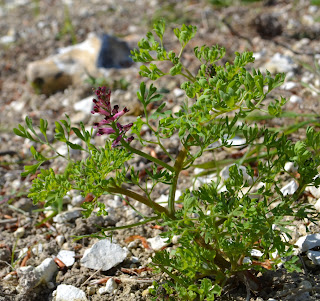All day (could be
half - see end)) OS
Landranger 174: Newbury & Wantage
This
area is now part of the North Wessex Downs Area of Outstanding Natural Beauty
(AONB). The botanically interesting
section was once a Wildlife Trust reserve, but this seems to have been discontinued. Nevertheless, for the moment at least, it is
still a special spot and has an Open Access area reached via permissive paths.
We
parked at SU573838 where the ancient Fair Mile track meets the A417 and followed
the wide path west up Kingstanding Hill.
This path is between hedgerow and a belt of woodland with all the
expected hedge and chalk species - hedgerow cranesbill Geranium pyrenaicum, white campion Silene latifolia, wild basil Clinopodium
vulgare, privet Ligustrum vulgare,
spurge laurel Daphne laureola,
spindle Euonymus europaeus, dogwood Cornus sanguinea, green alkanet Pentaglottis sempervirens, wild
mignonette Reseda lutea, wild
strawberry Fragaria vesca, wild
parsnip Pastinaca sativa, salad-burnet
Sanguisorba minor, dewberry Rubus caesius, wild carrot Daucus carota, wayfaring tree Viburnum lantana, restharrow Ononis repens; and the garden escapes
balm Melissa officinalis, columbine Aquilegia vulgaris and spearmint Mentha spicata.
Hedgerow cranesbill
Common fumitory
We
briefly caught sight of a Green Hairstreak butterfly gathering nectar on green
alkanet and then sunning itself on the bare path.
Green hairstreak
Common Rockrose
The "Fair Mile",
Cholsey Downs
Woolly Thistle leaves
Xanthoria
parietina
Musk thistle bud just
opening
We
also saw stitchwort-like flowers in the long grass which had hairy stems and
shorter greener leaves than greater stitchwort - the uncommon field mouse-ear Cerastium arvense.
Field mouse-ear
We
crossed another major track and then had a view across sheep pasture and the
Aston Upthorpe Downs.
Aston Upthorpe Downs
The
scrubby valley below the sheep pasture is the location of the former nature
reserve. We took the next track off to
the right, passing field pansy Viola
arvensis and a field full of cowslips Primula
veris. Shortly on the right were
signs for a permissive path and Access
Land
Aston Upthorpe valley with
juniper, looking north
Juniper bush
Conspicuous in the turf were low clustered spikes of deep blue flowers with bright white stamens well exposed - the rare chalk milkwort Polygala calcarea. Although they looked immediately different from the laxer spikes of less intensively blue flowers of common milkwort, we checked by looking at the base of the flowering stems, where there were rosettes of larger spoon-shaped leaves, whereas in the common species the leaves get increasingly small down the stem. The sepals, too, had simple veins, not the anastomosing ones of Polygala vulgaris. This plant was distributed over most of the valley and common milkwort was very rare, although we did find a few plants with pink flowers.
Chalk milkwort
Other plants here included wall
speedwell Veronica arvensis, dwarf
thistle Cirsium acaule, glaucous
sedge Carex flacca, fairy flax Linum catharticum, thyme-leaved sandwort
Arenaria serpyllifolia, horseshoe
vetch Hippocrepis comosa, bulbous
buttercup Ranunculus bulbosus, early
forgetmenot Myosotis ramosissima and field forgetmenot
M. arvensis, sticky mouse-ear Cerastium glomeratum and common
mouse-ear Cerastium fonatanum, mouse-ear
hawkweed Pilosella officinarum and
salad burnet. The dominant grass was
tor-grass Brachypodium rupestre. At the southern end was also more field
mouse-ear.
Horseshoe vetch
Towards the bottom of the valley there was a small enclosure protecting many pasque flowers Pulsatilla vulgaris, mostly individually caged and almost all now in seed, and a few young junipers, protecting them from rabbit grazing. A few pasque flowers also grew nearby outside the fence.
Pasque flower
Near
them was a single plant of the equally rare field fleawort Tephroseris integrifolia, as yet only just in bud. There would no doubt be more to be found at a
later date.
Field fleawort in bud
A
few dingy and grizzled skippers were flying, among brimstone, comma, large
white, common blue, orange-tip, small copper, peacock and small
tortoiseshell. We left the valley at the
north end and continued down the path to the twin villages of Aston Upthorpe
and Aston Tirrold. In the latter a verge
had garden star-of-Bethlehem Ornithogalum
umbellatum. In the churchyard there
was bugle Ajuga reptans.
Garden star-of-Bethlehem
Bugle in churchyard
We stopped at the Sweet Olive for lunch, where there was a huge choice of original meals and welcome drinks.
We returned along the same route,
but just south of Aston Tirrold, across the A417, we explored a permissive
side-path on the right to an open access area on the side of Riddle Hill, where
there was also good chalk turf. Here
again were cowslip, woolly thistle, fairy flax, rockrose, salad burnet, both
common and chalk milkworts, dwarf thistle and also wild thyme Thymus polytrichus. Grizzled skipper was also flying here.
Riddle Hill
We
returned to the lane where, looking back there was a fine view to Aston
Tirrold, with a large old flowering walnut Juglans
regia tree to our left.
Lane looking north to Aston
Tirrold, walnut tree on left
There
was bladder campion Silene vulgaris
in the verge, Spanish bluebell Hyacinthoides
hispanica and a group of bearded iris Iris
germanica.
Bearded iris
We returned through the former reserve, discovering a group of deadly nightshade Atropa belladonna in the shade of a group of elder Sambucus nigra bushes.
Although we searched assiduously we
could find no evidence of burnt-tip orchid Orchis
ustulata, which we had seen here in 1979 (photo below). It has apparently
not been seen here since 1992.
Burnt-tip orchid, Aston
Upthorpe, June 1979
One would not miss much by making this a shorter half-day trip by starting at Aston Tirrold and walking to the southern end of the Aston Upthorpe former reserve and returning the same way, with or without the side excursion to Riddle Hill, although the view from Fair Mile above helps put it all in the context of the general landscape.






















No comments:
Post a Comment